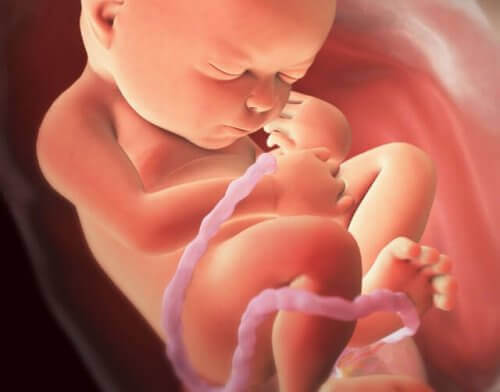What Is Congenital Heart Disease?

During pregnancy, some fetuses can develop abnormalities or defects. Congenital heart disease is one of the most common ones. Learn about it here.
There are many different types of abnormalities that can affect all parts of babies’ bodies, ranging from the hands to the heart.
Many future mothers start to hear all about different issues, which makes them ask this question: What is congenital heart disease?
The word cardiopathy refers to any condition of the heart and cardiovascular system. On the other hand, the term congenital means “present condition at birth.”
Nowadays, we know a lot more about this condition. There’s a lot of information regarding what causes it, what the different types are, its symptoms and treatments.
Congenital heart disease
Before, we had a specific definition for congenital heart disease. It’s a birth defect where the baby’s heart has structural and cardiovascular problems.
Now, when we talk about this disease, it can actually refer to a large number of heart conditions. It has the potential of putting your baby’s life in danger for the first year. However, with the right treatment, you can get through this condition.
According to the American Academy of Pediatrics, between 1% and 2% of babies are born with malformations.
Meanwhile, according to the American Heart Association, 9 out of every 1,000 babies have this disease at birth. This data shows that congenital heart disease is one of the most common defects.

Causes of congenital heart disease
Now, let’s look at some of the possible causes of congenital heart disease in babies. As you know, babies’ hearts start developing at conception. They’re completely developed by the eighth week of pregnancy.
During those weeks, this defect will develop. The main cause is that the heart didn’t go through all of the necessary stages.
It’s still a mystery as to why this happens. Most of the time, doctors can’t find a specific reason. In addition, there’s nothing mothers can do to prevent it.
“It’s a birth defect where the baby’s heart has structural and cardiovascular problems.”
Types of congenital heart disease
Congenital heart disease has a few different classifications. In cardiology, it can have cyanotic and non-cyanotic causes. Some of the problems babies can suffer from are:
- Reduced blood flow to the lungs: When this happens, the baby’s blood lacks oxygen. Therefore, the same thing happens throughout the body. This leads to the child being cyanotic. Therefore, the skin looks bluish.
- Too much blood flow to the lungs: This causes the lungs to work excessively. In addition, the child’s blood pressure increases.
- Little blood flow through the body: This occurs when the blood vessels are blocked and the blood can’t flow properly.
Starting from these problems, cardiologists will start treating the defects that cause them. This includes arterial ducts and interatrial communication.
It can also include ventricular channels, pulmonary valves, and more. Often, more than one heart disease can happen at the same time.

Treatment for heart disease
Pediatric cardiologists are responsible for treating each case in a specific way. They can detect certain problems even when the baby is still in the womb. However, others can stay hidden until the baby is born.
To treat these conditions, specialists will decide what the most effective treatment is for the child. Some treatments can include medications and even operations. It all depends on each case and how severe it is.
The doctor will decide when to have a surgery. Sometimes, babies need surgery immediately. On the other hand, some babies need to wait months or even years.
During pregnancy, some fetuses can develop abnormalities or defects. Congenital heart disease is one of the most common ones. Learn about it here.
There are many different types of abnormalities that can affect all parts of babies’ bodies, ranging from the hands to the heart.
Many future mothers start to hear all about different issues, which makes them ask this question: What is congenital heart disease?
The word cardiopathy refers to any condition of the heart and cardiovascular system. On the other hand, the term congenital means “present condition at birth.”
Nowadays, we know a lot more about this condition. There’s a lot of information regarding what causes it, what the different types are, its symptoms and treatments.
Congenital heart disease
Before, we had a specific definition for congenital heart disease. It’s a birth defect where the baby’s heart has structural and cardiovascular problems.
Now, when we talk about this disease, it can actually refer to a large number of heart conditions. It has the potential of putting your baby’s life in danger for the first year. However, with the right treatment, you can get through this condition.
According to the American Academy of Pediatrics, between 1% and 2% of babies are born with malformations.
Meanwhile, according to the American Heart Association, 9 out of every 1,000 babies have this disease at birth. This data shows that congenital heart disease is one of the most common defects.

Causes of congenital heart disease
Now, let’s look at some of the possible causes of congenital heart disease in babies. As you know, babies’ hearts start developing at conception. They’re completely developed by the eighth week of pregnancy.
During those weeks, this defect will develop. The main cause is that the heart didn’t go through all of the necessary stages.
It’s still a mystery as to why this happens. Most of the time, doctors can’t find a specific reason. In addition, there’s nothing mothers can do to prevent it.
“It’s a birth defect where the baby’s heart has structural and cardiovascular problems.”
Types of congenital heart disease
Congenital heart disease has a few different classifications. In cardiology, it can have cyanotic and non-cyanotic causes. Some of the problems babies can suffer from are:
- Reduced blood flow to the lungs: When this happens, the baby’s blood lacks oxygen. Therefore, the same thing happens throughout the body. This leads to the child being cyanotic. Therefore, the skin looks bluish.
- Too much blood flow to the lungs: This causes the lungs to work excessively. In addition, the child’s blood pressure increases.
- Little blood flow through the body: This occurs when the blood vessels are blocked and the blood can’t flow properly.
Starting from these problems, cardiologists will start treating the defects that cause them. This includes arterial ducts and interatrial communication.
It can also include ventricular channels, pulmonary valves, and more. Often, more than one heart disease can happen at the same time.

Treatment for heart disease
Pediatric cardiologists are responsible for treating each case in a specific way. They can detect certain problems even when the baby is still in the womb. However, others can stay hidden until the baby is born.
To treat these conditions, specialists will decide what the most effective treatment is for the child. Some treatments can include medications and even operations. It all depends on each case and how severe it is.
The doctor will decide when to have a surgery. Sometimes, babies need surgery immediately. On the other hand, some babies need to wait months or even years.
This text is provided for informational purposes only and does not replace consultation with a professional. If in doubt, consult your specialist.








